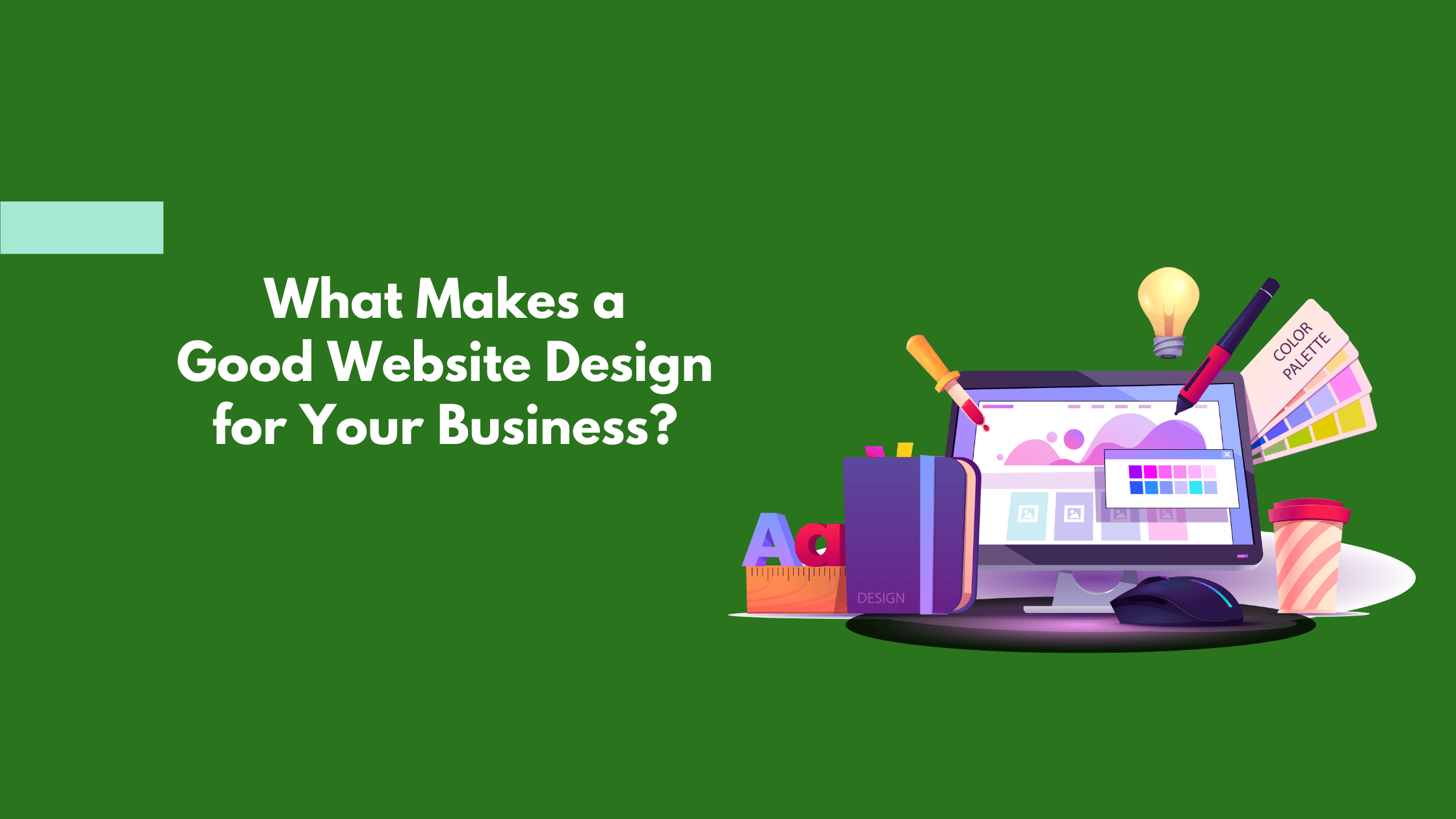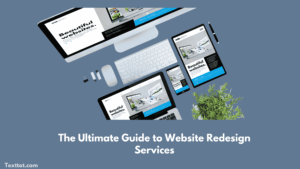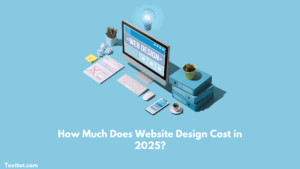Have you ever landed on a website that looked so outdated or confusing that you immediately hit the back button? You’re not alone.
A website is the digital face of your business, and if it’s not designed well, potential customers won’t stick around long enough to see what you offer.
Good website design isn’t just about making a site look pretty, it’s about creating a seamless experience that attracts visitors, keeps them engaged, and ultimately converts them into customers.
Think about it–would you trust a business with a cluttered, slow, or poorly structured website? Probably not. Studies show that 75% of consumers judge a company’s credibility based on its website design.
That means if your site doesn’t look professional and function smoothly, you’re losing business before you even get a chance to pitch your products or services.
So, what makes a good website design? In this guide, we’ll break down the best website design principles and show you how to create an effective web design that not only looks good but also drives real business results.
But first, why does your business need a good website design?
Table of Contents
Why Good Website Design Matters for Your Business
Imagine walking into a store with dim lighting, messy shelves, and no clear signs to guide you. You’d probably walk right out, right?
That’s exactly how visitors feel when they land on a poorly designed website. Your website isn’t just a digital placeholder, it’s really your 24/7 salesperson, brand ambassador, and lead generator all rolled into one. If it’s not designed well, you’re turning away potential customers before they even get to know what you offer.
A good website design does more than just look nice. It builds trust, enhances user experience, and drives conversions.
In fact, research shows that 88% of users won’t return to a site after a bad experience. And with more than half of global website traffic coming from mobile devices, having a responsive and easy-to-navigate website is a necessity.
Not convinced? Let’s talk about numbers. Slow-loading websites costs businesses $2.6 billion in lost revenue every year because people simply won’t wait. Even a one-second delay can lower conversion rates by 20%. That means if your site isn’t fast, clear, and engaging, you’re leaving money on the table.
The good news is that at Texttot Digital, we specialize in turning underperforming websites into high-converting assets. Whether your site needs a design refresh, better navigation, or a speed boost, we’ve got you covered. And if you’re wondering whether your website is working as hard as it should, why not get a free website audit to find out?
The Core Principles of Effective Web Design
Now that we know why good website design matters, let’s break down the best website design principles that make a website effective.
A website isn’t just about aesthetics, it’s about functionality, user experience, and performance. If your site isn’t built on a solid foundation, you’ll struggle to keep visitors engaged and convert them into customers. What are the core principles of effective web design?
User-Centric Design
If you’ve ever visited a website that felt confusing or overwhelming, that’s a sign of poor design. A website should always be built with the user in mind. Studies show that 76% of consumers say the most important factor in a website’s design is ease of use. That means visitors should be able to find what they need without clicking through endless pages or getting lost in confusing menus.
A great example of user-centric design is clear navigation. Your visitors shouldn’t have to guess where to click next. Keep your menu simple, highlight important pages like services or pricing, and make it effortless for them to take action, whether that’s filling out a form, making a purchase, or booking a consultation.
Mobile Responsiveness
More than 58% of web traffic comes from mobile devices, yet many business owners still overlook mobile optimization. A website that isn’t mobile-friendly is turning away potential customers.
Google also ranks mobile-friendly websites higher in search results, so if your site isn’t responsive, you’re hurting both your user experience and your SEO.
If visitors have to pinch and zoom to read your content, struggle to tap buttons, or encounter broken layouts, they won’t stick around. The best way to ensure a seamless experience is by using responsive web design, which automatically adjusts to different screen sizes.
A well-optimized mobile site improves user experience, increases engagement, and boosts search rankings.
Fast Loading Speed
Here’s a fact: 53% of users abandon a website if it takes longer than 3 seconds to load. Speed matters. A slow website frustrates visitors and costs you conversions. Even a small delay can impact your bottom line. Amazon found that a 1-second delay in load time could cost them $1.6 billion in sales per year.
As a business owner, you can significantly improve your website speed by optimizing images, reducing unnecessary scripts, and using caching techniques.
Clear and Intuitive Navigation
A messy navigation is a common website mistake that kills conversion. Your website should feel natural to navigate. It’s simple; when users don’t have to struggle to find information, they stay longer and are more likely to take action. The fewer clicks it takes to find what they need or looking for, the better.
Having a clean and intuitive navigation structure keeps visitors engaged and guides them toward action. Your menu should be simple and well-organized, ideally with no more than five to seven main options.
Labels should be clear and straightforward, using vague terms like “Solutions” or “More” only confuses visitors. And using a search bar can make it easier for users to find specific content, while breadcrumb navigation helps them understand where they are on your site.
High-Quality Visuals and Branding
Your website’s design should align with your brand identity. Professional photography, custom graphics, consistent colours and engaging visuals create a more trustworthy and compelling user experience.
Remember it takes just 50 milliseconds for users to form an opinion about your website, so make those first moments count. When users see authentic images, they connect with your brand more easily.
Using blurry images or mismatched branding can make a website look unprofessional. If you want to elevate your brand with a professional web presence, our team at Texttot Digital specializes in high-quality web design that aligns with your business identity.
Strong Calls to Action (CTAs)
Imagine a visitor lands on your website, reads about your services, and then… nothing. If your CTAs aren’t clear, visible, and compelling, you’re missing out on potential conversions.
A website should always guide visitors toward the next step, whether that’s scheduling a consultation, downloading a free resource, or making a purchase.
An effective CTA should stand out visually and be placed strategically throughout the website. Instead of vague phrases like “Learn More,” using action-driven CTAs such as “Get a Free Quote,” “Download Our Guide,” or “Start Your Free Trial” tend to work better. When users know exactly what to do next, conversion rates improve.
SEO-Friendly Structure
You see, a beautifully designed website is useless if no one can find it. Many business owners assume that simply launching a website is enough to attract visitors, but without proper optimization, it won’t even show up in search results. That’s why a good website design goes hand-in-hand with SEO.
This means using clean code, optimizing page speed, structuring content with proper headings and meta descriptions, and strategically placing keywords throughout your site. Another overlooked factor is image alt text, which helps search engines understand the content of images. Internal linking is just as important, as it improves navigation and boosts SEO.
If you want a full breakdown of SEO essentials, take a look at our SEO checklist for business websites. And if your site isn’t ranking well, Texttot Digital offers SEO audits to help identify areas for improvement.
Secure and Trustworthy Design
Would you enter your credit card details on a sketchy-looking website? Probably not. Security matters, especially for businesses handling customer data.
Having an SSL certificate reassures visitors that your site is safe. Testimonials and reviews build credibility by showcasing real feedback from previous customers. A portfolio or case studies provide proof of expertise, while secure payment badges instil confidence in e-commerce shoppers.
If you’re serious about growing your business online, investing in a secure and professional website is non-negotiable.
How to Choose the Right Website Design for Your Business
Now that we’ve covered the best website design principles, let’s talk about why choosing the right website design is important for your business.
Choosing the right website design isn’t just about picking a pretty layout. Your site should reflect your brand, engage your audience, and drive conversions. In fact, a well-designed website acts as your storefront, shaping first impressions and guiding visitors toward taking action. But with so many design options available, how do you know which one suits your business best?
Understanding Your Business Needs and Goals
Before diving into design choices, take a step back and define what you need from your website. Are you looking to sell products online, generate leads, showcase a portfolio, or build brand awareness?
A local service-based business will have different design requirements than an e-commerce store. If you’re an entrepreneur, your website might need strong personal branding, while a SaaS company would prioritize lead generation and customer onboarding.
Think about the essential features you need. An e-commerce business requires a seamless checkout process and product pages, while a consulting firm benefits from a booking system and detailed service pages.
Choosing Between Custom and Template-Based Design
One of the biggest decisions you’ll face is whether to go with a custom website design or use a pre-made template. Each has its pros and cons, depending on your budget, goals, and level of customization required.
Template-based designs are a cost-effective option for businesses that need a simple, quick setup. Some website platforms like Wix, Squarespace, and Shopify offer beautiful pre-designed templates, but they come with limitations. You might struggle with customization, branding consistency, and scalability.
On the other hand, a custom website design offers complete flexibility, ensuring that every element aligns with your brand and business objectives. They are built with the best website design principles in mind, ensuring optimal performance, SEO-friendliness, and user experience.
They also provide more room for future growth, allowing you to scale your online business with advanced web features as your business expands.
Prioritizing User Experience (UX) and Mobile Optimization
A good website design isn’t just about aesthetics, it’s about functionality. No matter how visually appealing your site is, if visitors struggle to navigate it, they won’t stick around. A cluttered layout, confusing menu, or poorly placed CTAs can drive potential customers away.
Your website should be intuitive and easy to navigate by having clear headings, logical page structures, and a streamlined design to help users find information quickly.
As said earlier, mobile optimization is also very crucial because Google prioritizes mobile-friendly sites in search rankings. So, if your site doesn’t adjust to different screen sizes, you’re missing out on potential customers.
Selecting the Right Color Scheme, Typography, and Visuals
Your website’s colours, fonts, and images contribute to your brand’s identity and user experience. Colour psychology plays a huge role in influencing visitors’ emotions and actions. In time, blue conveys trust and professionalism, making it a popular choice for financial and tech companies. Red stimulates urgency, often used in e-commerce and sales-driven websites.
One of the best website design principles is to consider your typography. Readable fonts enhance user experience, while overly decorative ones can be distracting. Stick to professional, clean fonts that align with your brand. Let your visuals have high quality and be relevant to your business. Using stock photos can make your site feel impersonal, whereas custom images and branded graphics build authenticity and credibility.
Ensuring SEO and Performance Optimization
A website that looks great but doesn’t rank in search engines won’t do your business any favours. SEO-friendly design includes fast loading speeds, mobile responsiveness, optimized images, structured data, and keyword-rich content. Technical SEO elements like meta descriptions, alt text for images, and internal linking all contribute to better rankings.
A slow website will not only frustrate your users but also tank your ranking on Google.
Integrating Conversion-Optimized Features
Your website should be designed with conversions in mind. Whether your goal is to collect leads, drive sales, or increase engagement, strategic placement of CTAs is crucial. Visitors shouldn’t have to search for ways to contact you, sign up, or purchase a product. Your CTAs should be clear, visible, and compelling.
Live chat functionality can also boost engagement and conversions by offering real-time assistance. Pop-ups, when used strategically, can help with lead generation. Trust elements like testimonials, reviews, and security badges further reassure visitors.
How to Assess and Improve Your Website Design
One thing about a good website design is that it needs to function smoothly, load quickly, and guide visitors toward taking action. If your site isn’t bringing in leads or sales, then, it’s time for an assessment.
The good news? You don’t need to be a tech expert to evaluate your website’s performance. In fact, you can improve your website performance without necessarily redesigning it. You only need the right tools and you can turn an underperforming website into a high-converting one.
Simple Ways to Audit Website Performance
Before making any changes, you need to understand how well your website is performing. Start by visiting your site as if you were a customer. Is it easy to navigate? Do the pages load quickly? Can you find important information without searching too hard? A slow, confusing, or outdated website can drive visitors away before they even explore your business.
Next, check your website’s performance metrics using Google Analytics. Look at your bounce rate (how quickly visitors leave), time spent on pages, and conversion rates. If people aren’t staying long or completing actions like filling out forms or making purchases, your website design might need improvement.
Also, if your site takes forever to load, that’s another red flag. Remember, speed isn’t only important for user experience, it affects your search engine rankings.
Tools for Testing Website Performance and User Behavior
Thankfully, you don’t have to guess what’s wrong with your website. There are free and paid analytics tools that track your website’s effectiveness and help you make data-driven improvements. They are:
- Google PageSpeed Insights – This tool shows how fast your website loads and gives suggestions for speeding it up.
- Google Search Console – Helps identify broken links, mobile usability issues, and SEO problems.
- Hotjar and Crazy Egg – These heatmap tools show where users click, scroll, and drop off, helping you understand how they interact with your site.
- GTmetrix – Analyzes page speed and performance with detailed reports.
Using these tools, you can spot issues like slow-loading images, confusing navigation, or ineffective CTAs.
Although small fixes can improve a site’s performance, some problems just require expert help. If your site looks outdated, isn’t mobile-friendly, or fails to generate leads, a professional website design can make a huge difference.
So, don’t hesitate to reach out to us at Texttot Digital. We specialize in effective web design that improves user experience, boosts conversions, and enhances SEO. If your website isn’t delivering the results you need, it’s definitely time for a refresh.
Conclusion
A website is an investment in your business’s future, so it’s important to follow the best website design principles that scale with your needs. A good website design balances aesthetics, user experience, performance, and conversion potential.
Choosing the right design means understanding your goals, balancing branding with usability, and ensuring SEO and performance optimization. Whether you opt for a custom website design or a template, prioritize mobile-friendliness, fast load times, and conversion-driven elements.
Do you need help choosing the best website design for your business or you’re not even sure where to start? Get a free website audit from us today at Texttot Digital and let’s identify the changes that will make your site work better for your business!



